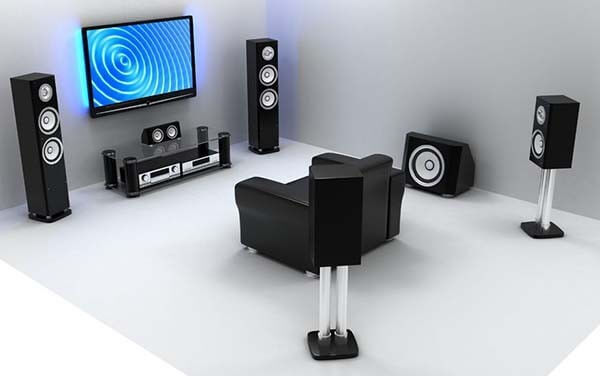There are many factors that effect how your speaker system sounds including the quality of your speakers, speaker placement, the quality of your subwoofer, and most importantly the specific acoustics of the room they live in. Some of these factors can’t be changed but that doesn’t mean you should settle for anything less than the absolute best that your system is capable of.
Maybe you’ve just purchased your first surround sound speaker system, or you’ve just upgraded to a new system, or perhaps you’ve had your system for a while, whatever your situation is, calibrating your speakers is essential to getting the most out of your home theater experience.
why calibrate your speakers?
The sound engineers that created the rich enveloping soundtrack that plays over the images in your favorite movies and television shows mixed everything to create a specific experience. Calibrating your system allows you to experience that soundtrack the way it was intended to be experienced.
Without proper calibration you may get different volume levels from different speakers causing sound effects to be too loud or too soft from one speaker to the next, throwing off the positioning of different elements across the sound stage, and generally sounding unbalanced and fatiguing.
what about digital room correction?
Not all DRC systems are created equal. While Anthem’s ARC is almost universally considered to be fantastic, along with the runner up Audyssey MultiEQ XT32, even the third runner up Audyssey MultiEQ XT is considered by many professionals to provide mixed and inconsistent results. After that you start to see varying degrees of inadequacy all the way down to systems that are considered universally terrible.
By calibrating your system manually you can achieve better results than many of the DRC solutions can provide. And best of all it’s a process that can be done in less than an hour at very little cost. And considering what you’ve already invested in assembling your home theater system, a little bit more money is well worth it to get the best audio experience possible short of paying for a professional calibration.
what tools do you need?
The first thing you’ll need is a sound pressure level meter. An SPL meter is essentially a device with a small microphone that allows you to determine the volume level of your speakers in decibels. The go-to SPL meter for home theater hobbyists used to be the analog Radio Shack model, despite some slight inaccuracies, however that was discontinued some time ago. Today you can pick up a relatively inexpensive SPL on Amazon for around $60.
Your SPL meter will need to have A and C weighting and Fast and Slow speed options as well as at least a 60 to 100 decibel range.
You will also need a small home video camera tripod. You can get one for as little as $12 if you don’t already have one sitting around the house. However if you don’t want to buy one you can use a step ladder, a small chair, a box, etc. That being said, I recommend the tripod as you will be able to easily point the SPL meter at the ceiling.
basic surround sound speaker setup
You will find any number of tips for speaker placement from casual suggestions to fanatical insistence upon exact angles of degree and adjustments to the half inch. Aside from pointing you to this Dolby article on speaker placement, all I will say is make sure your front left and right speakers are at least six feet apart and pointed toward the primary seating position, or the sweet spot. However make sure that they are not aimed at your head but are aimed to just outside your elbows.

Your surround speakers should be 12 to 24 inches above your ear level when you’re seated and they should be on either side of the sweet spot. In a 7.1 system your surround back speakers should be at that same height and at least four feet apart. For tips on subwoofer placement see our article How to Find the Perfect Subwoofer Placement.
s.p.l. meter settings
Your SPL meter should be placed on the tripod in your primary listening position with the microphone at your seated ear level. It should be pointed at the front of the room and tilted towards the ceiling at roughly 45 degrees or pointed straight up. It should be set to C weighting and Slow. And finally it should be set to either 75 or 80 db. Finally make sure that the battery is relatively fresh or it could impact the sensitivity.
receiver or processor settings
You will need to use your receivers test tone feature in the on screen menu so consult your manual for where to find it. This feature is often called Speaker Levels. The test tones are pink noise played through each speaker starting with the left front speaker and then moving clockwise around the room. Most receivers play their pink noise at 75 decibels regardless of what the master volume is set to but, just in case, set your receivers volume for 75 decibels before hand. In the Speaker Levels menu make sure that each speaker is set to 0 db before you begin.
In the speaker setup menu you will want to make sure that each speaker is set to small, regardless of the physical size of the speaker. All this does is make sure that the low frequency bass signals are sent to the subwoofer instead of the speakers. This frees up your main speakers to put all of their power into the mid range and high frequencies. For subwoofer crossover settings, as well as crossover settings for individual speakers, see our subwoofer article.
calibrating the speakers
While you’re taking your readings, make sure that you stand to the side of the SPL meter and not behind it. Your body will absorb sound frequencies and distort the results. And of course do not stand between the SPL meter and the speaker you’re testing.
Starting with the front left speaker in the Speaker Levels menu, adjust the level up or down until the SPL meter reads 75db. The range of adjustment should be from +10db to -10db, with 0db in the middle. If the reading on the SPL meter fluctuates just above or below 75db, don’t worry. You’re just trying to get it as close as you can.
Then repeat this process for the center, front right, and so on down the list. Once you’ve calibrated all of the speaker levels to 75db, go ahead and increase the surround speakers by 1db each and, after testing your settings with a few movies or TV shows, you can always increase the level of the center channel a decibel or two if the dialogue seems too low. Finally if you have a good quality subwoofer and you want a little extra punch from your bass, you can increase the subwoofer level to as much as 5db higher.
calibrating the subwoofer
Because the low frequencies from the subwoofer bounce around the room causing different areas to have more or less bass, you may want to take readings from all of the different listening positions to find its average. So once you have initially calibrated it to 75db in the sweet spot, place the meter in each seating position and take note of the reading. Lets say your readings are 75db, 70db, 80db, 85db, and 75db, giving you an average of 77db, to compensate you would lower the subwoofer level by 2db.
what about using a calibration disc?
Calibration discs like Disney World of Wonder, Digital Video Essentials HD Basics, and Spears & Munsil HD Benchmark all have audio calibration tools that have easy to follow walk throughs that allow you to easily calibrate your system a little more accurately than the process outlined above. Any of these discs can be had for $30 dollars or less.
what about professional calibration?
A professional calibration of your home theater system cannot be beat by the basic calibration steps outlined above. Professionals use precision measuring tools and computer software to determine your current performance, adjust the speaker placement and listening positions, make EQ adjustments when possible, and fine tune your system to compensate for the limitations of your room and equipment. The difference is pretty dramatic when all is said and done.
That being said, this basic calibration can get you about three quarters of the way there, which is good enough for many people and tremendously better than no calibration at all! And for those that want even more, not only can you hire a pro, but you can also invest in acoustical treatments and equipment upgrades that will bring you to audio nirvana.
final thoughts
Calibrating your surround sound system is essential to recreating the movie going experience at home and allows you to experience movies and TV shows the way the film makers intended. For less than a hundred dollars, and an hour of your time, you can drastically improve the performance of your home theater and be the envy of your movie loving friends.
Chances are you bought a surround sound system because you love watching movies, so why wouldn’t you take that one step further to properly calibrate it? After you calibrate your system, and enjoy a couple of movies, let us know in the comments what your results were and if you had any trouble following our guide.


Dear Mr.Raul … really your article was so wonderful with a very great professional way I have never met on line any where … thanks so much.. but I have a very important question… does manual calibration is fair enough instead of going throug audessy or better to do both and check the results ? second thing I didn’t understand in the statement as you wrote ( Starting with the front left speaker in the Speaker Levels menu, adjust the level up or down until the SPL meter reads 75db. The range of adjustment should be from +10db to -10db, with 0db in the middle. If the reading on the SPL meter fluctuates just above or below 75db, don’t worry. You’re just trying to get it as close as you can. how I can adjust the speaker level up or down until spl reads 75db… u mean I have to use the receiver remote control ? Last thing like to know : do I need to put spl in many raw positions or just the main listening spot ? Thanks so much and wishing U all the best.
Hi Alaa, Thank you for the kind words. I always prefer manual calibration unless you have Anthem’s ARC. By calibrating your system manually you can achieve better results than many of the digital room calibration solutions can provide. As for making the speaker adjustments, you’ll have to check your receiver’s manual to find the instructions for adjusting the speaker levels but you’ll definitely use the remote to make the adjustments. Finally, you’ll want to place the SPL meter in the “sweet spot” at ear level. The sweet spot is your main listening position, usually your favorite seat lined up with the center channel speaker and the middle of the screen.
Thanks so much or your fast kind response, by the way my receiver is Denon AVR-X6400H 11.2.